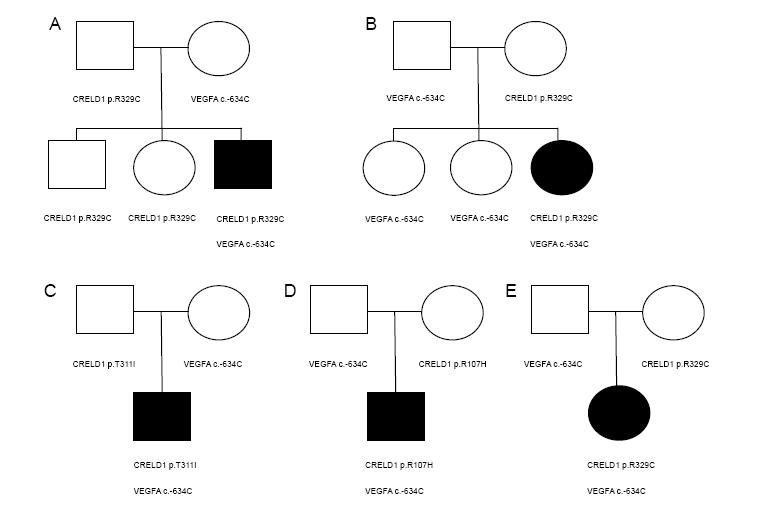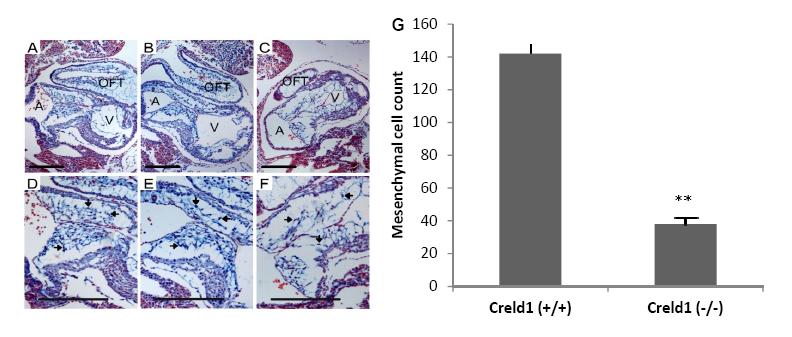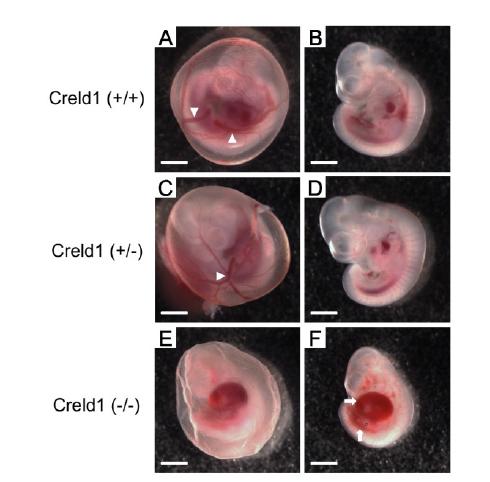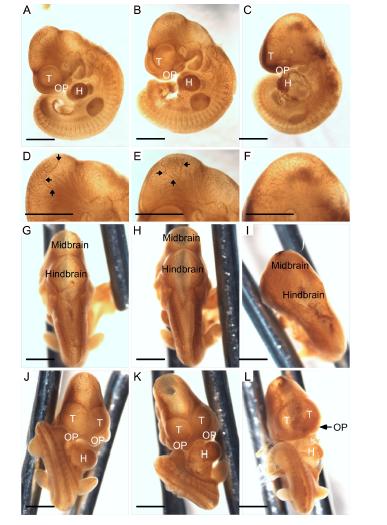Atrioventricular septal defects (AVSD) are highly heritable, clinically significant congenital heart malformations. Genetic and environmental modifiers of risk are thought to work in unknown combinations to cause AVSD. Approximately 5–10% of simplex AVSD cases carry a missense mutation in CRELD1. However, CRELD1 mutations are not fully penetrant and require interactions with other risk factors to result in AVSD. Vascular endothelial growth factor-A (VEGFA) is a well-characterized modulator of heart valve development. A functional VEGFA polymorphism, VEGFA c.-634C, which causes constitutively increased VEGFA expression, has been associated with cardiac septal defects suggesting it may be a genetic risk factor. To determine if there is an allelic association with AVSD we genotyped the VEGFA c.-634 SNP in a simplex AVSD study cohort. Over-representation of the c.-634C allele in the AVSD group suggested that this genotype may increase risk. Correlation of CRELD1 and VEGFA genotypes revealed that potentially pathogenic missense mutations in CRELD1 were always accompanied by the VEGFA c.-634C allele in individuals with AVSD suggesting a potentially pathogenic allelic interaction. We used a Creld1 knockout mouse model to determine the effect of deficiency of Creld1 combined with increased VEGFA on atrioventricular canal development. Morphogenic response to VEGFA was abnormal in Creld1-deficient embryonic hearts, indicating that interaction between CRELD1 and VEGFA has the potential to alter atrioventricular canal morphogenesis. This supports our hypothesis that an additive effect between missense mutations in CRELD1 and a functional SNP in VEGFA contributes to the pathogenesis of AVSD.
1.
Introduction
In recent decades, importance of fractional order models is well disclosed fact in many fields of engineering and science. Numerous fractional order partial differential equations(FPDEs) have been used by many authors to describe various important biological and physical processes like in the fields of chemistry, biology, mechanics, polymer, economics, biophysics control theory and aerodynamics. In this concern, many researchers have studied various schemes and aspects of PDEs and FPDEs as well, see [1,2,3,4,5,6,7,8,9,10]. However, the great attention has been given very recently to obtaining the solution of fractional models of the physical interest. Keeping in views, the computation complexities involved in fractional order models is very crucial and is the difficulty in solving these fractional models. Some times, the exact analytic solution of each and every FPDE can not be obtained using the traditional schemes and methods. However, there exists some schemes and methods, which have been proved to be efficient in obtaining the approximation to solution of the fractional order problems. Among them, we bring the attention of readers to these methods and schemes [11,12,13,14,15,16,17,18,19,20,21] which are used successfully. These methods and schemes have their own demerits and merits. Some of them provide a very good approximation with convenient way. For example, see the methods and schemes in the articles [22,23,24,25,26,27,28,29,30,31,32,33,34,35,36,37,38,39].
The main aim of this work is to develop a new procedure which is easy with respect to application and more efficient as compare with existing procedures. In this concern, we introduced asymptotic homotopy perturbation method (AHPM) to obtain the solution of nonlinear fractional order models. It is a new version of perturbation techniques. In simulation section, we have testified our proposed procedure by considering the test problems of non linear fractional order Zakharov-Kuznetsov $ ZK(m, n, r) $ equations of the form [11,12]
Where $ a_0 $, $ a_1 $, $ a_2 $ are arbitrary constants and $ m, n, r $ are non zero integers. If $ \alpha = 1, $ then equation (1.1) becomes classical Zakharov-Kuznetsov $ ZK(m, n, r) $ equation given as:
The ZK equation has been firstly modelized for depicting weakly nonlinear ion-acoustic waves in strongly magnetized lossless plasma [40]. The ZK equation governs the behavior of weakly nonlinear ion-acoustic waves in plasma comprising cold ions and hot isothermal electrons in the presence of a uniform magnetic field [41,42].
The plan of the rest paper is as follows: Section 2 provides theory of the AHPM; Section 3 provides implementation of AHPM. Finally, a brief conclusion and the further work has been listed.
2.
Basic idea of AHPM
Here, we provide that the Caputo type fractional order derivative will be used throughout this paper for the computation of derivative.
Let us consider the nonlinear problem in the form as
Where $ T\left({u\left({x, y, t} \right)} \right) $ denotes a differential operator which may consists ordinary, partial or space- fractional or time-fractional differential derivative. $ T\left({u\left({x, y, t} \right)} \right) $ can be expressed for fractional model as follows:
subject to the condition
where the operator $ \frac{{{\partial ^\alpha }}}{{\partial {t^\alpha }}} $ denotes the Caputo derivative operator, $ N $ is non linear operator and $ B $ denotes a boundary operator, $ u\left({x, y, t} \right) $ is unknown exact solution of Eq. (2.1), $ g\left({x, y, t} \right) $ denotes known function and $ x, y $ and $ t $ denote special and temporal variables respectively. Let us construct a homotopy $ \Phi (x, y, t;p):\Omega \times \left[{0, 1} \right] \to R $ which satisfies
where $ p \in \left[{0, 1} \right] $ is said to be an embedding parameter. At this phase of our work it is pertinent that our proposed deformation Eq. (2.5) is an alternate form of the deformation equations as
and
in HPM, HAM, OHAM proposed by Liao in [43], He in [44] and Marinca in [45] respectively.
Basically, according to homotopy definition, when $ p = 0 $ and $ p = 1 $ we have
Obviously, when the embedding parameter $ p $ varies from $ 0 $ to $ 1 $, the defined homotopy ensures the convergence of $ \phi \left({x, y, t;p} \right) $ to the exact solution $ u\left({x, y, t} \right) $. Consider $ \phi \left({x, y, t;p} \right) $ in the form
and assuming $ N\left({\Phi \left({x, y, t;p} \right)} \right) $ as follows
Where
are arbitrary auxiliary functions, will be discussed later. Thus, if $ p = 0 $ and $ p = 1 $ in Eq. (2.5), we have
respectively.
It is obvious that the construction of introduced auxiliary function in Eq. (2.10) is different from the auxiliary functions that are proposed in articles [43,44,45]. Hence the procedure proposed in our paper is different from the procedures proposed by Liao, He, Marinca in aforesaid papers [43,44,45] as well as Optimal Homotopy perturbation method (OHPM) in [46].
Furthermore, when we substitute Eq. (2.9) and Eq. (2.10) in Eq. (2.5) and equate like power of $ p $, the obtained series of simpler linear problems are
We obtain the series solutions by using the integral operator $ {J^\alpha } $ on both sides of the above each simple fractional differential equation. The convergence of the series solution Eq. (2.9) to the exact solution depends upon the auxiliary parameters (functions) $ {B_i}(x, y, t, {c_i}) $. The choice of $ {B_i}(x, y, t, {c_i}) $ is purely on the basis of terms appear in nonlinear part of the Eq. (2.1). The Eq.(2.9) converges to the exact solution of Eq. (2.1) at $ p = 1 $:
Particularly, we can truncate the Eq. (2.12) into finite m-terms to obtain the solution of nonlinear problem. The auxiliary convergence control constants $ {c_1}, {c_2}, {c_3}, \dots $ can be found by solving the system
It can be verified to observe that HPM is only a case of Eq. (2.5) when $ p = -p $ and
The HAM is also a case of Eq. (2.5) when $ p = ph $ and
The OHAM is also another case when
in Eq. (2.10), we obtain exactly the series problems which are obtained by OHAM after expanding and equating the like power of $ p $ in deformation equation. Furthermore, concerning the Optimal Homotopy Asymptotic Method (OHAM) mentioned in this manuscript and presented in [45], that the version of OHAM proposed in 2008 was improved in time and the most recent improvement, which also contains an auxiliary functions, are presented in the papers [47,48]. We also have improved the version of OHAM by introducing a very new auxiliary function in Eq. (2.10). Our method proposed in this paper uses a very new and more general form of auxiliary function
which depends on arbitrary parameters $ {B_1}, {B_2}, {B_3}, \dots $ and is useful for adjusting and controlling the convergence of nonlinear part as well as linear part of the problem with simple way.
3.
Applications
In this portion, we apply AHPM to obtain solution of the following problems to show the accuracy and appropriateness of the new procedure for to solve nonlinear problems.
Problem 3.1. Let us consider FZK$ (2, 2, 2) $ in the form:
subject to the condition
When $ \alpha = 1 $. Then the exact solution of Eq. (3.1):
As in Eq. (3.1), the non linear part
Now, follow the procedure of AHPM, we obtain series of the simpler linear problems as:
Zero order problem:
First order problem:
Second order problem:
Third order problem:
Fourth order problem:
and so on.
Solving the above equations, the respective solutions from Eqs. (3.2)–(3.6) are given as follow:
so on $\dots$.
In similar way, we can compute the solution of the next simpler linear problems which are difficult to compute by using OHAM procedure. we choose $ {{B_1} = {c_1}, B_2} = {c_2}, {B_3} = {c_3}, {B_4} = {c_4} $ and consider
The residual:
We obtain number of optimal values of auxiliary constants by using the Eq. (2.13) and choose those optimal values whose sum is in $ \left[{- 1, } \right.\left. 0 \right) $. Now, substituting the optimal values of auxiliary constants (from the Table 1) into the Eq. (3.12), we obtain the AHPM solutions for different values of $ \alpha $ at $ k = 0.001 $
If $ \alpha = 1, $ then we have
If $ \alpha = 0.75, $ then we have
If $ \alpha = 0.67, $ then we have
Tables 2 and 3 show the AHPM solution, VIM solution, exact solution and absolute error of AHPM solution. It is obvious from Tables 2 and 3 that AHPM solution results are more accurate to the exact solution results as compare with VIM [11] solution results. The AHPM solution, exact solution and absolute error of AHPM solution are plotted for different values of $ \alpha $, $ x $, $ y $ and $ t $ in Figures 1 and 2. The curves of AHPM and exact solution are exactly matching as compare with homotopy perturbation transform method (HPTM)[12]. It is obvious from the Tables 2 and 3, Figures 1 and 2, that the AHPM solution of the problem 3.1 is in very good agreement with exact solution.
Problem 3.2. Now, we consider FZK$ (3, 3, 3) $ in the form:
subject to condition
When $ \alpha = 1 $. Then the exact solution of equation (3.14):
As in Eq. (3.14), the non linear part:
Now, follow the procedure of AHPM, we obtain series of the simpler linear problems as follow:
Zero order problem:
First order problem:
Second order problem:
Third order problem:
Fourth order problem:
The respective solutions of the Eqs. (3.15)–(3.19) are given as follow:
and so on.
In similar way, we can compute the solution of the next simpler linear problems. We choose $ {{B_1} = {c_1}, B_2} = {c_2}, {B_3} = {c_3}, {B_4} = {c_4} $ and consider
We compute the residual;
We obtain number of optimal values of auxiliary constants by using the Eq. (2.13) and choose those optimal values whose sum is in $ \left[{- 1, } \right.\left. 0 \right) $. Now, substituting the optimal values of auxiliary constants (from Table 4) into the Eq. (3.20), we obtain the AHPM solutions for different values of $ \alpha $ at $ k = 0.001. $
If $ \alpha = 1, $ then we have
If $ \alpha = 0.75, $ then we have
If $ \alpha = 0.67, $ then we have
Tables 5–7 show the AHPM solution, VIM solution, exact solution and absolute error of AHPM solution. The AHPM solution, exact solution and absolute error of AHPM solution are plotted for different values of $ \alpha $, $ x $, $ y $ and $ t $ in Figures 3 and 4. It is obvious from the Tables 5–7, Figures 3 and 4, that the AHPM solution of the problem 3.2 is in very good agreement with exact solution.
4.
Discussion and conclusions
In this article, asymptotic homotopy perturbation method (AHPM) is developed to solve non-linear fractional models. It is a different procedure from the procedures of HAM, HPM and OHAM. The two special cases, $ ZK(2, 2, 2) $ and $ ZK(3, 3, 3) $ of fractional Zakharov-Kuznetsov model are considered to illustrate a very simple procedure of the homotopy methods. The numerical results in simulation section of AHPM solutions are more accurate to the exact solutions as comparing with fractional complex transform (FCT) using variational iteration method (VIM). In the field of fractional calculus, it is necessary to introduce various procedures and schemes to compute the solution of non-linear fractional models. In this concern, we expect that this new proposed procedure is a best effort. The best improvement and the application of this new procedures to the solution of advanced non-linear fractional models with computer software codes will be our further consideration.
Acknowledgments
The authors would like to thank anonymous referees for their careful corrections to and valuable comments on the original version of this paper.
Conflict of interest
The authors declare no conflict of interest.









 DownLoad:
DownLoad:













